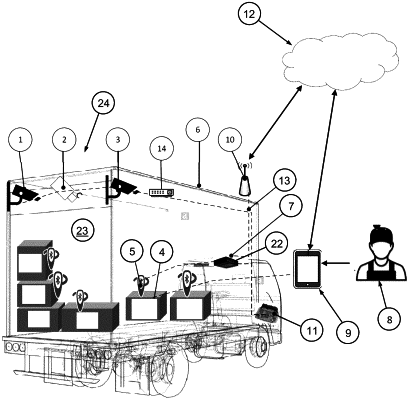| CPC G06V 10/809 (2022.01) [G06T 7/70 (2017.01); G06V 20/59 (2022.01); H04W 4/025 (2013.01); H04W 4/38 (2018.02); H04W 4/80 (2018.02)] | 8 Claims |

|
1. A tracking system for tracking tools in and nearby a transportation vehicle, the system including:
a plurality of tool sets that is arrangeable in a vehicle loading space of the transportation vehicle at least during transportation, wherein each tool set includes a tool and at least one fixedly attached short-range wireless network communication member;
a short-range wireless network communication receiving unit that is arrangeable in the vehicle loading space and that is configured to receive signals transmitted by and unique to each short-range wireless network communication member;
a vehicle-based detection unit having one or more optical cameras and a LIDAR sensor device that are each separate from the tool sets and arrangeable in the vehicle loading space for optically acquiring at least a portion of the vehicle loading space and at least a portion of the plurality of tool sets at least in the vehicle loading space from different angles, wherein the one or more optical cameras and the LIDAR sensor device are configured for providing digital image data as well as corresponding range information for the at least a portion of the plurality of tool sets;
an electronic main controller unit, which is operatively coupled at least to the wireless network communication receiving unit, which is configured to communicate with the vehicle-based detection unit, and which is configured to communicate with a cloud-based computer system;
a mobile computing unit including an optical camera, a LIDAR sensor device, and configured to wirelessly communicate with the electronic main controller unit and a cloud-based computer system; and
the cloud-based computer system comprising at least one trained artificial neural network that at least serves as a basis for providing a prediction output regarding identity and location of tool sets of the plurality of tool sets, based on digital image data and corresponding range information provided by the vehicle-based detection unit.
|